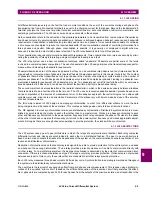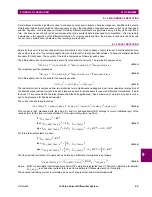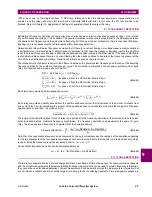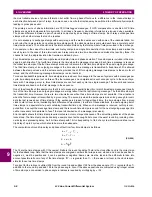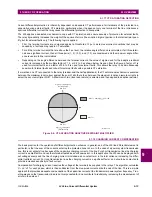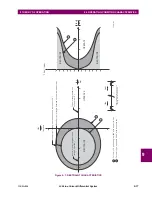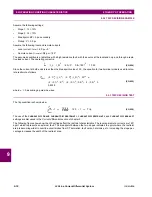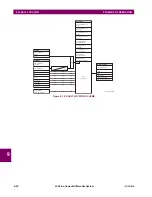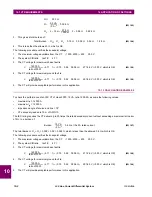
GE Multilin
L30 Line Current Differential System
9-15
9 THEORY OF OPERATION
9.1 OVERVIEW
9
The major difference between the L30 differential scheme and a percent differential scheme is the use of an estimate of
errors in the input currents to increase the restraint parameter during faults, permitting the use of more sensitive settings
than those used in the traditional scheme. The inclusion of the adaptive feature in the scheme produces element character-
istic equations that appear to be different from the traditional scheme, but the differences are minimal during system
steady-state conditions. The element equations are shown in the
Operating condition calculations
section.
9.1.20 RELAY SYNCHRONIZATION
On startup of the relays, the channel status will be checked first. If channel status is OK, all relays will send a special
“startup” message and the synchronization process will be initiated. It will take about 5 to 7 seconds to declare PFLL status
as OK and to start performing current differential calculations. If one of the relays was powered off during the operation, the
synchronization process will restart from the beginning. Relays tolerate channel delay (resulting sometimes in step change
in communication paths) or interruptions up to four power cycles round trip time (about 66 ms at 60 Hz) without any deteri-
oration in performance. If communications are interrupted for more than four cycles, the following applies:
In two-terminal mode
:
1.
With second redundant channel, relays will not lose functionality at all if second channel is live.
2.
With one channel only, relays have a five second time window. If the channel is restored within this time, it takes about
two to three power cycles of valid PFLL calculations (and if estimated error is still within margin) to declare that PFLL is
OK. If the channel is restored later than 5 seconds, PFLL at both relays will be declared as failed and the re-synchroni-
zation process will be initiated (about 5 to 7 seconds) after channel status becomes OK.
In three-terminal mode
:
1.
If one of the channels fails, the configuration reverts from master-master to master-slave where the master relay has
both channels live. The master relay PFLL keeps the two slave relays in synchronization, and therefore there is no
time limit for functionality. The PFLL of the slave relays will be suspended (that is, the 87L function will not be per-
formed at these relays but they can still trip via DTT from the master relay) until the channel is restored. If the esti-
mated error is within margin upon channel restoration and after two to three power cycles of valid PFLL calculations,
the PFLL will be declared as OK and the configuration will revert back to master-master.
2.
If 2 channels fail, PFLL at all relays will be declared as failed and when the channels are back into service, the re-syn-
chronization process will be initiated (about 5 to 7 seconds) after channel status becomes OK.
Depending on the system configuration (number of terminals and channels), the 87L function operability depends on the
status of channel(s), status of synchronization, and status of channel(s) ID validation. All these states are available as Flex-
Logic™ operands, for viewing in actual values, logged in the event recorder (if events are enabled in 87L menu), and also
trigger targets (if targets are enabled in the 87L function). These FlexLogic™ operands can to be used to trigger alarms,
illuminate LEDs, and be captured in oscillography.
However, the
87L BLOCKED
FlexLogic™ operand reflects whether the local current differential function is blocked due to
communications or settings problems. The state of this operand is based on the combination of conditions outlined above.
As such, it is recommended that it be used to enable backup protection if 87L is not available.
The
87L BLOCKED
operand is set when the 87L function is enabled and any of the following three conditions apply:
1.
At least one channel failed on a two or three-terminal single-channel system, or both channels failed on a two-terminal
two-channel system.
2.
PFFL has failed or is suspended,
3.
A channel ID failure has been detected on at least one channel in a two-terminal single-channel system or in a three-
terminal system, or a channel ID failure has been detected on both channels in a two-terminal dual-channel system.
All L30 communications alarms can be divided by major and minor alarms.
The major alarms are
CHANNEL FAIL
,
PFLL FAIL
, and
CHANNEL ID FAIL
. The relay is blocked automatically if any of these
conditions occur. Therefore, there is no need to assign these operands to a current differential block setting.
The minor alarms are
CRC FAIL
and
LOST PACKET
, which are indicators of a poor or noisy communications channel. If the
relay recognizes that a packet is lost or corrupted, the 87L feature is not processed at that protection pass. Instead, it waits
for the next valid packet.
Summary of Contents for L30
Page 10: ...x L30 Line Current Differential System GE Multilin TABLE OF CONTENTS ...
Page 30: ...1 20 L30 Line Current Differential System GE Multilin 1 5 USING THE RELAY 1 GETTING STARTED 1 ...
Page 370: ...5 244 L30 Line Current Differential System GE Multilin 5 10 TESTING 5 SETTINGS 5 ...
Page 464: ...A 10 L30 Line Current Differential System GE Multilin A 1 PARAMETER LISTS APPENDIX A A ...
Page 600: ...C 30 L30 Line Current Differential System GE Multilin C 7 LOGICAL NODES APPENDIX C C ...
Page 610: ...D 10 L30 Line Current Differential System GE Multilin D 1 IEC 60870 5 104 APPENDIX D D ...
Page 622: ...E 12 L30 Line Current Differential System GE Multilin E 2 DNP POINT LISTS APPENDIX E E ...
Page 634: ...F 12 L30 Line Current Differential System GE Multilin F 3 WARRANTY APPENDIX F F ...
Page 644: ...x L30 Line Current Differential System GE Multilin INDEX ...

